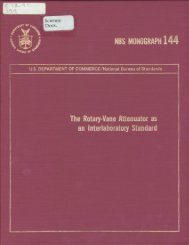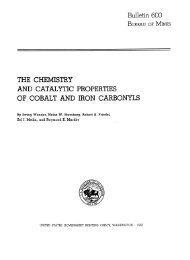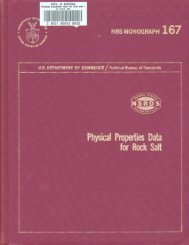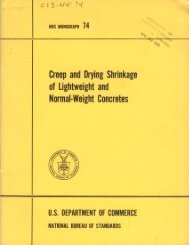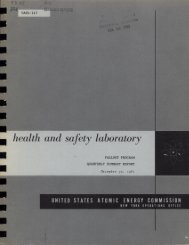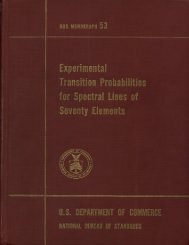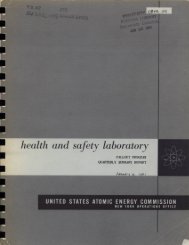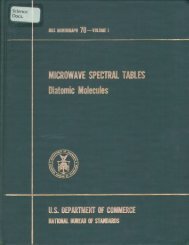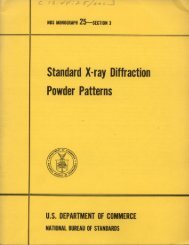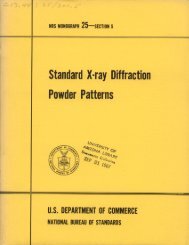Corrosion of Steel Pilings in Soils
Corrosion of Steel Pilings in Soils
Corrosion of Steel Pilings in Soils
- No tags were found...
You also want an ePaper? Increase the reach of your titles
YUMPU automatically turns print PDFs into web optimized ePapers that Google loves.
Elevationft256 to 236_____ __256 to 226------250248 5247246—— - —— _-„_Soil resistivity and pH — Cont<strong>in</strong>uedM<strong>in</strong>MaxAvgM<strong>in</strong>MaxAvgM<strong>in</strong>MaxAvgResistivityOhm-cm3,400 (4-p<strong>in</strong>) __ __ __6,900 (4-p<strong>in</strong>)_-____ ___ _4,300 (4-p<strong>in</strong>)___________2,700 (4-p<strong>in</strong>)____________3,800 (4-p<strong>in</strong>)____________3,500 (4-p<strong>in</strong>)____________2,400 (Laboratorv) ___ _4,000 (Laboratorv) ______4,300 (Laboratory) _ _ _5,000 (Shepard Canes) _ _ _11,000 (Shepard Canes) __7,900 (Shepard Canes). __pR4 46 46. 9Condition <strong>of</strong> piles:251.5 to 248 ft: Mill scale was present over 70percent <strong>of</strong> the surface. Many highly localized pitscorroded about 15 percent <strong>of</strong> the surface, the rema<strong>in</strong><strong>in</strong>g 85 percent <strong>of</strong> the surface was unaffected bycorrosion. Six pits were found between 100 and 172mils <strong>in</strong> depth, eight pits between 50 and 95 mils, andother pits measured less than 50 mils. The corrosionproducts and soil particles adher<strong>in</strong>g to the steel <strong>in</strong>this zone were easily scraped <strong>of</strong>f.248 to 246: About 30 percent <strong>of</strong> the pil<strong>in</strong>g surfaceswere affected by scattered pits, the other areas be<strong>in</strong>gunaffected by corrosion. Mill scale was <strong>in</strong>tact overmore than 50 percent <strong>of</strong> the surface. The sevendeepest pits ranged between 105 and 160 mils <strong>in</strong>depth. Also present were 11 pits between 50 and 95mils and other pits less than 50 mils <strong>in</strong> depth. Theaverage reduction <strong>in</strong> wall thickness measured <strong>in</strong> thethree most corroded areas was between 12 and 19percent. In this zone, the soil particles were easilyscraped from the steel surfaces, but a black crust <strong>of</strong>ferric oxide which was embedded <strong>in</strong> the pits wasdifficult to break away.e. Berwick Lock, Berwick, LouisianaHistory:Two excavations were made to expose steel pil<strong>in</strong>gs<strong>in</strong> the cut<strong>of</strong>f walls on the west side and east side <strong>of</strong>the north end <strong>of</strong> the Berwick Lock which is locatedbetween the Lower Atchafalaya River and BerwickBay near Berwick, La. The arch-type sheet steelpil<strong>in</strong>gs had a driv<strong>in</strong>g width <strong>of</strong> 19% <strong>in</strong>. and a % <strong>in</strong>.wall thickness.Date piles driven: March 1949Date <strong>of</strong> <strong>in</strong>spection: April 1960Age <strong>of</strong> pil<strong>in</strong>g: 11.1 yearsNORTH END OF LOCK—WEST SIDEPil<strong>in</strong>g exposed: A 5-ft width <strong>of</strong> pil<strong>in</strong>gs was exposedbetween elevation +3.5 to —1.5 ft. One side <strong>of</strong> thepil<strong>in</strong>gs which was uncoated, was totally exposed tothe soil environment. The other side <strong>of</strong> the pil<strong>in</strong>gs15had a coal tar coat<strong>in</strong>g and was exposed to water.Surface elevation: + 5 f tWater table elevation: —0.5 ftSoil characteristics:+ 5 to + 2 ft: Fill material consist<strong>in</strong>g <strong>of</strong> a mixture<strong>of</strong> gray and brown silty clay conta<strong>in</strong><strong>in</strong>g some graveland small shells.+ 2 to —1.5: Natural soil consist<strong>in</strong>g <strong>of</strong> tight bluishgray impervious plastic clay with patches <strong>of</strong> tightbrown clay dispersed throughout the pr<strong>of</strong>ile.Elevationft+ 5 to -5_+ 5 to —15_+ 5 to -25_-1__.0__--1.5-Soil resistivity and pHM<strong>in</strong>MaxAvgResistivityOhm-cm860 (4-p<strong>in</strong>) _.960 (4-p<strong>in</strong>) _.900 (4-p<strong>in</strong>)..M<strong>in</strong> 990 (4-p<strong>in</strong>).Max 1, 260 (4-p<strong>in</strong>).Avg 1, 190 (4-p<strong>in</strong>).M<strong>in</strong> 1, 380 (4-p<strong>in</strong>).Max 1, 550 (4-p<strong>in</strong>).Avg 1, 440 (4-p<strong>in</strong>).M<strong>in</strong> 680 (Shepard Canes),Max 950 (Shepard Canes) _Avg 820 (Shepard Canes).1, 000 (Shepard Canes).1,400 (Laboratory).„__1, 290 (Laboratory) ____850 (Shepard Canes) _800 (Shepard Canes).850 (Shepard Canes) _8. 58. 1Condition <strong>of</strong> piles:+ 3.5 to +1.5 ft: Mill scale was <strong>in</strong>tact over 40percent <strong>of</strong> the surface. The rema<strong>in</strong><strong>in</strong>g surface wasuniformly attacked and had many shallow pits lessthan 25 mils <strong>in</strong> depth, and some deeper pits. Afew pits ranged between 55 and 61 mils <strong>in</strong> depth,and many others ranged between 25 and 55 mils.The average reduction <strong>in</strong> wall thickness observed onthe three most corroded areas was between 6 and 8percent.+1.5 to —1.5 ft: Mill scale was <strong>in</strong>tact over about60 percent <strong>of</strong> the surface. Slight uniform corrosionwas present on the rema<strong>in</strong><strong>in</strong>g surface and there weremany pits which did not exceed 25 mils <strong>in</strong> depth.There was slight general metal attack and pitt<strong>in</strong>gover the entire coated side <strong>of</strong> the pil<strong>in</strong>gs which wasexposed on the water side. The river water had aresistivity <strong>of</strong> 2,500 ohm-cm, and a salt content <strong>of</strong>40 ppm.NORTH END OF LOCK—EAST SIDEPil<strong>in</strong>g exposed: A 5 ft width <strong>of</strong> the wall was exposedbetween elevation +3.5 and 0 ft.Surface elevation: + 5 f tWater table elevation: + 1 f tSoil characteristics:+ 5 to + 3 ft: Fill consist<strong>in</strong>g <strong>of</strong> a mixture <strong>of</strong> slightly



